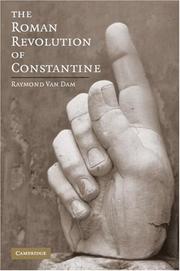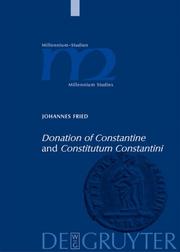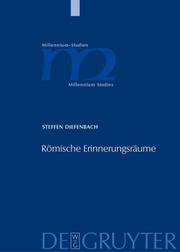| Listing 1 - 7 of 7 |
Sort by
|
Book
ISBN: 9781107096431 110709643X 9780511973048 9781107644496 1107644496 1139064193 1107222427 113907671X 9786613112910 1139083538 1139078992 1139070991 0511973047 1283112914 1139081268 Year: 2011 Publisher: Cambridge Cambridge University Press
Abstract | Keywords | Export | Availability | Bookmark
 Loading...
Loading...Choose an application
- Reference Manager
- EndNote
- RefWorks (Direct export to RefWorks)
"Constantine was the first Christian emperor in the Roman empire. Before his victory in 312 at the battle of the Milvian Bridge outside Rome, he claimed to have seen a vision of a cross in the sky. The book analyzes the legends about the battle and the vision, from the later Roman empire to the later medieval period. By rehabilitating the significance of Maxentius, the losing emperor, this book also emphasizes the competing ideas at stake about Roman emperorship, the contours of the empire,and the place of Rome"--
Saxa Rubra, Battle of, Italy, 312 --- Bataille du Pont Milvius, Italie, 312 --- Constantine --- Maxentius, Marcus Aurelius Valerius, --- Arts and Humanities --- History --- Constantin empereur --- Constantine - I, - Emperor of Rome, - d. 337 --- Maxentius, Marcus Aurelius Valerius, - Emperor of Rome, - d. 312 --- Saxa Rubra, Battle of, Italy, 312. --- Milvian Bridge, Battle of, Italy, 312 --- Saxa Rubra, Battle of, 312 --- Massenzio, --- Constantijn, --- Constantin, --- Constantin --- Constantine, --- Constantino --- Constantinus Flavius Valerius Aurelius, --- Constantinus --- Constantinus, --- Costantino --- Costantino, --- Flaviĭ Valeriĭ Avreliĭ Konstantin, --- Flavius Valerius Aurelius Constantinus Augustus, --- Flavius Valerius Aurelius Constantinus, --- Flavius Valerius Constantinus, --- Konstantin, --- Konstantin --- Kōnstantinos, --- Kōnstantinos --- Konstantyn, --- Kostandianos --- Κωνσταντίνος, --- Флавий Валерий Аврелий Константин, --- Константин --- Константин, --- Flavije Valerije Konstantin

ISBN: 110718519X 0511341040 128108526X 9786611085261 0511819471 0511342152 0511341628 0511574215 0511342683 9780511342684 9780511341045 9780511819476 9780511574214 9780521882095 0521882095 9780521133012 0521133017 Year: 2007 Publisher: New York Cambridge University Press
Abstract | Keywords | Export | Availability | Bookmark
 Loading...
Loading...Choose an application
- Reference Manager
- EndNote
- RefWorks (Direct export to RefWorks)
The reign of the emperor Constantine (306-337) was as revolutionary for the transformation of Rome's Mediterranean empire as that of Augustus, the first emperor three centuries earlier. The abandonment of Rome signaled the increasing importance of frontier zones in northern and central Europe and the Middle East. The foundation of Constantinople as a new imperial residence and the rise of Greek as the language of administration previewed the establishment of a separate eastern Roman empire. Constantine's patronage of Christianity required both a new theology of the Christian Trinity and a new political image of a Christian emperor. Raymond Van Dam explores and interprets each of these events. His book complements accounts of the role of Christianity by highlighting ideological and cultural aspects of the transition to a post-Roman world.
Church history --- Apostolic Church --- Christianity --- Church, Apostolic --- Early Christianity --- Early church --- Primitive and early church --- Primitive Christianity --- Fathers of the church --- Great Apostasy (Mormon doctrine) --- Constantine --- Constantijn, --- Constantin, --- Constantin --- Constantine, --- Constantino --- Constantinus Flavius Valerius Aurelius, --- Constantinus --- Constantinus, --- Costantino --- Costantino, --- Flaviĭ Valeriĭ Avreliĭ Konstantin, --- Flavius Valerius Aurelius Constantinus Augustus, --- Flavius Valerius Aurelius Constantinus, --- Flavius Valerius Constantinus, --- Konstantin, --- Konstantin --- Kōnstantinos, --- Kōnstantinos --- Konstantyn, --- Kostandianos --- Κωνσταντίνος, --- Флавий Валерий Аврелий Константин, --- Константин --- Константин, --- Flavije Valerije Konstantin --- Rome --- History --- Eglise --- Histoire --- Arts and Humanities --- Church history - Primitive and early church, ca. 30-600 --- Constantin empereur --- Constantine - I, - Emperor of Rome, - d. 337

ISBN: 9783110185393 3110185393 3110902230 9783110902235 Year: 2007 Volume: Bd. 3 Publisher: Berlin ; New York : Walter de Gruyter,
Abstract | Keywords | Export | Availability | Bookmark
 Loading...
Loading...Choose an application
- Reference Manager
- EndNote
- RefWorks (Direct export to RefWorks)
Die Konstantinische Schenkung ist die ungeheuerlichste, wirkmächtigste Fälschung der Weltgeschichte. Allein die Frage nach ihrer Entstehungszeit beschäftigte Generationen von Wissenschaftlern. Was aber genau ist die Konstantinische Schenkung? Zur Beantwortung dieser Frage ist die Unterscheidung zweier semantischer Ebenen unerlässlich: zum einen das Constitutum Constantini, ein fiktives Privileg, in dem u.a. die der römischen Kirche von Kaiser Konstantin aus Dankbarkeit gewährten Rechte und Geschenke aufgeführt werden, zum anderen die Konstantinische Schenkung als ein sich seit der Mitte des 11. Jahrhunderts ausformendes Erinnerungsbild und Jedermannswissen. Nicht nur die Entstehung des Constitutum Constantini wird vom Autor völlig neu interpretiert, nämlich der fränkischen Opposition gegen Kaiser Ludwig den Frommen zugeschrieben, sondern auch die Geschichte seines bis in die Textimplantationen reichenden Missverständnisses seit dem Hohen Mittelalter dargestellt. Der Band enthält im Anhang alle relevanten Texte im Original und in englischer Übersetzung. The Donation of Constantine is the most outrageous and powerful forgery in world history. The question of its precise time of origin alone kept generations of researchers occupied. But, what exactly is the Donation of Constantine? To find the answer, it is necessary to approach the question on two different semantic levels: First, as the Constitutum Constantini, a fictitious privilege, in which, among other things, rights and presents were bestowed on the catholic church by a grateful Emperor Konstantin. Secondly, as a reflection of the Middle Age mindset, becoming part of the culture landscape midway through 11th century A.D. The author not only reinterprets the origin of this forgery (i.e. puts it down to the Franks' opposition of Emperor Louis the Pious), but retells, as well, the history of its misinterpretation since the High Middle Ages. In an appendix, all relevant texts are printed in the original language, an English translation is provided.
Church and state --- Rescripts (Roman law) --- Church history --- Eglise et Etat --- Rescrits --- Eglise --- History. --- Forgeries. --- Histoire --- Faux --- Constantine --- Constitutum Constantini. --- Roman law --- Constantijn, --- Constantin, --- Constantin --- Constantine, --- Constantino --- Constantinus Flavius Valerius Aurelius, --- Constantinus --- Constantinus, --- Costantino --- Costantino, --- Flaviĭ Valeriĭ Avreliĭ Konstantin, --- Flavius Valerius Aurelius Constantinus Augustus, --- Flavius Valerius Aurelius Constantinus, --- Flavius Valerius Constantinus, --- Konstantin, --- Konstantin --- Kōnstantinos, --- Kōnstantinos --- Konstantyn, --- Kostandianos --- Κωνσταντίνος, --- Флавий Валерий Аврелий Константин, --- Константин --- Константин, --- Flavije Valerije Konstantin --- Constitutum Constantini --- Costituto di Costantino --- Donatio Constantini --- Donation of Constantine --- Donazione di Costantino --- Konstantinische Schenkung --- Privilegia sacerdotum --- Donation of Constantine. --- Middle Ages. --- Donation dite de Constantin --- Constantin Ier (empereur romain ; 027.?-0337) --- Donation de Constantin --- Rescrits (droit romain) --- Europe --- Jusqu'à 1500 --- Constantin empereur
Book
ISSN: 18621139 ISBN: 9783110227888 3110227886 9783110227895 3110482304 9786612673191 3110227894 128267319X 9783110482300 Year: 2010 Volume: 27 27 Publisher: Berlin : De Gruyter,
Abstract | Keywords | Export | Availability | Bookmark
 Loading...
Loading...Choose an application
- Reference Manager
- EndNote
- RefWorks (Direct export to RefWorks)
Die Einstellung Konstantins des Großen zum Christengott und die Motive und Ziele der Politik des Kaisers gegenüber den Christen und ihrem Klerus sind bis heute umstritten. In Auseinandersetzung mit der Forschung der letzten 150 Jahre bietet der Autor zunächst eine in verschiedenen Einzelaspekten neue Rekonstruktion der Abwendung Konstantins vom Paganismus und seiner Hinwendung zum Christentum in den Jahren 310 bis 312. Analysiert werden sodann im Kontext des Aufstiegs zur Alleinherrschaft seine frühesten Selbstzeugnisse als Christ, seine 312 massiv einsetzende ideelle und materielle Förderung von christlichem Klerus und Kirchengemeinden und seine Rolle als ,Bischof der Bischöfe' (episcopus episcoporum, pontifex maximus) bis zu seinem Tod 337. Dabei kommt auch seine Politik gegenüber den nichtchristlichen Religionen zur Sprache. Maßgebend war, so zeigt sich, nicht der Gedanke der ,Toleranz', sondern angesichts der überwältigend großen Mehrheit der Nichtchristen in den Führungsschichten von Armee und Gesellschaft und in der Reichsbevölkerung insgesamt der Gesichtspunkt der ordnungspolitischen Opportunität. Konstantin strebte keine Parität, keinen Pluralismus, keine Koexistenz der Religionen an: das Christentum sollte zur alleinigen Reichs- und Weltreligion werden.
Church history --- Church and state --- Eglise --- Eglise et Etat --- Histoire --- Constantine --- History --- Church and state -- Rome -- History. --- Church history -- 4th century. --- Constantine I, Emperor of Rome, d. 337. --- Religion --- Christianity --- Philosophy & Religion --- 937.08 --- 27 "03" --- Geschiedenis van Rome: absolutistisch keizerrijk van Diocletianus tot de val van Rome--(284-476 n. Chr.) --- Kerkgeschiedenis--?"03" --- 937.08 Geschiedenis van Rome: absolutistisch keizerrijk van Diocletianus tot de val van Rome--(284-476 n. Chr.) --- Constantijn, --- Constantin, --- Constantin --- Constantine, --- Constantino --- Constantinus Flavius Valerius Aurelius, --- Constantinus --- Constantinus, --- Costantino --- Costantino, --- Flaviĭ Valeriĭ Avreliĭ Konstantin, --- Flavius Valerius Aurelius Constantinus Augustus, --- Flavius Valerius Aurelius Constantinus, --- Flavius Valerius Constantinus, --- Konstantin, --- Konstantin --- Kōnstantinos, --- Kōnstantinos --- Konstantyn, --- Kostandianos --- Κωνσταντίνος, --- Флавий Валерий Аврелий Константин, --- Константин --- Константин, --- Flavije Valerije Konstantin --- Influence --- History. --- Religions --- Constantine the Great. --- Constantinian Revolution. --- History of Councils. --- Late Antique Christianity. --- Religious Politics/Christianity. --- Church history - 4th century --- Church and state - Rome - History --- Constantin empereur --- Constantine - I, - Emperor of Rome, - d. 337

ISSN: 18621139 ISBN: 3110191296 9786612196171 1282196170 3110204266 9783110191295 Year: 2007 Volume: 11 Publisher: Berlin : Walter de Gruyter,
Abstract | Keywords | Export | Availability | Bookmark
 Loading...
Loading...Choose an application
- Reference Manager
- EndNote
- RefWorks (Direct export to RefWorks)
Rom unterlag zwischen dem 3. und 5. Jh. n. Chr. einem tief greifenden Transformationsprozess, der die urbane, soziale und religiöse Struktur der Stadt in gleicher Weise erfasste. Die vorliegende Studie nimmt mit der Heiligenerinnerung ein zentrales Feld dieses Wandels in den Blick. Ausgehend vom kulturwissenschaftlichen Paradigma kollektiver Identitätsstiftung durch Erinnerung, wird die Funktion der Heiligenmemoria im Hinblick auf unterschiedliche kollektiver Identitäten untersucht: die Gemeinschaft der Lebenden und Toten, die städtische Gemeinde der urbs Roma; die römische Kirche und schismastische Gemeindebildungen; der private Raum der domus; die durch die römischen Heiligenlegenden konstituierte literarische Öffentlichkeit. Angesichts der bedeutenden Rolle von Erinnerung für die antike Stadtkultur eröffnet die Heiligenmemoria zugleich eine neue Perspektive auf die städtische Entwicklung Roms im Übergang von der Spätantike zum Frühmittelalter insgesamt. Dabei ist Memoria selbst - so die abschließende These - mehr als nur ein Indikator von Veränderung: Die spezifisch christliche Konzeptualisierung von Erinnerung bildete eine der Voraussetzungen, die im Verein mit anderen Faktoren die Auflösung der spätantiken Stadt entscheidend beförderte.
Christian saints - Cult - Italy - Rome. --- Church history - Primitive and early church, ca 30-600. --- Rome (Italy) - Religious life and customs. --- 235.3 <37> --- Hagiografie--Rome. Oud-Italië --- Christian saints --- Church history --- Apostolic Church --- Christianity --- Church, Apostolic --- Early Christianity --- Early church --- Primitive and early church --- Primitive Christianity --- Fathers of the church --- Great Apostasy (Mormon doctrine) --- Saints --- Canonization --- Cult --- Rome (Italy) --- Rome (Italy : Commune) --- Rome (Italy : Governatorato) --- Rūmah (Italy) --- Roma (Italy) --- Rom (Italy) --- Rím (Italy) --- Rzym (Italy) --- Comune di Roma (Italy) --- Rome --- Religious life and customs. --- Religious life and customs --- Christian hagiography --- Group identity --- Saints chrétiens --- Hagiographie chrétienne --- Eglise --- Identité collective --- History. --- Culte --- Histoire --- Vie religieuse --- Christianity. --- cultural identity. --- hagiography. --- late antiquity. --- structural change. --- Rome (Italy : Comune) --- Christian saints - Cult - Italy - Rome --- Church history - Primitive and early church, ca. 30-600 --- Martyres Romani --- Constantin empereur --- Rome (Italy) - Religious life and customs
Book
ISBN: 9780520289604 9780520964204 0520289609 0520964209 0520308395 Year: 2016 Volume: 57 Publisher: Oakland, California
Abstract | Keywords | Export | Availability | Bookmark
 Loading...
Loading...Choose an application
- Reference Manager
- EndNote
- RefWorks (Direct export to RefWorks)
It is widely believed that the Emperor Constantine's conversion to Christianity politicized religious allegiances, dividing the Christian Roman Empire from the Zoroastrian Sasanian Empire and leading to the persecution of Christians in Persia. This account, however, is based on Greek ecclesiastical histories and Syriac martyrdom narratives that date to centuries after the fact. In this groundbreaking study, Kyle Smith analyzes diverse Greek, Latin, and Syriac sources to show that there was not a single history of fourth-century Mesopotamia. By examining the conflicting hagiographical and historical evidence, Constantine and the Captive Christians of Persia presents an evocative and evolving portrait of the first Christian emperor, uncovering how Syriac Christians manipulated the image of their western Christian counterparts to fashion their own political and religious identities during this century of radical change.
Syriac Christians --- Church history --- Chrétiens syriaques --- Eglise --- History --- Histoire --- Constantine --- Iraq --- Iran --- Irak --- 27 <394> --- Apostolic Church --- Christianity --- Church, Apostolic --- Early Christianity --- Early church --- Primitive and early church --- Primitive Christianity --- Fathers of the church --- Great Apostasy (Mormon doctrine) --- Syrian Christians --- Christians --- Kerkgeschiedenis--Syrië --- Constantijn, --- Constantin, --- Constantin --- Constantine, --- Constantino --- Constantinus Flavius Valerius Aurelius, --- Constantinus --- Constantinus, --- Costantino --- Costantino, --- Flaviĭ Valeriĭ Avreliĭ Konstantin, --- Flavius Valerius Aurelius Constantinus Augustus, --- Flavius Valerius Aurelius Constantinus, --- Flavius Valerius Constantinus, --- Konstantin, --- Konstantin --- Kōnstantinos, --- Kōnstantinos --- Konstantyn, --- Kostandianos --- Κωνσταντίνος, --- Флавий Валерий Аврелий Константин, --- Константин --- Константин, --- Syriac Christians. --- Primitive and early church. --- To 1500. --- Iran. --- Iraq. --- Chrétiens syriaques --- Flavije Valerije Konstantin --- Church history - Primitive and early church, ca. 30-600 --- Syriac Christians - History - To 1500 - Sources --- Syriac Christians - Iran - History - To 1500 --- Syriac Christians - Iraq - History - To 1500 --- Christianisme --- Symeon Bar-Sabba'e, m. --- Martyres Persae --- Sapor II, roi de Perse --- Sassanides --- Constantin empereur --- Iran - History - To 640 --- Iraq - History - To 634 --- 4th century mesopotamia. --- byzantine. --- christian converts. --- christian roman empire. --- constantine. --- conversion to christianity. --- eastern christians. --- ecclesiastical histories. --- first christian emperor. --- hagiography. --- history of constantine. --- history of persia. --- middle eastern christianity. --- persecution of christians in persia. --- persia. --- roman empire. --- sasanian empire. --- syriac christianity. --- syriac christians. --- zoroastrian sasanian empire.
Book
ISSN: 09285520 ISBN: 9789004191891 9004191895 9789004192102 9004192107 1283120321 9786613120328 Year: 2010 Volume: 88 Publisher: Leiden Boston Brill
Abstract | Keywords | Export | Availability | Bookmark
 Loading...
Loading...Choose an application
- Reference Manager
- EndNote
- RefWorks (Direct export to RefWorks)
The “Letter of Love and Concord” is a unique source, which allows us a glimpse into the political and religious aspirations of the Armenian Cilician elite at the end of the twelfth century, alluding to its hopes and expectations from the Crusades and the Church of Rome, as well as its uneasy relationship with the Byzantine Empire. The “Letter” is especially valuable for the wealth of information it contains on the royal ideology nurtured within the highest circles of the ruling Rubenid dynasty. The study provides an analysis of the sources used by its anonymous author, placing them within a historical context. Moreover, this marks the first time that a text based on the study of surviving sixty nine manuscripts along with its English translation has been made available for scholars.
Armenians --- Crusades --- History --- Tiridates --- Gregory, --- Constantine --- Sylvester --- Cilicia --- Armenians. --- Crusades. --- Christianisierung. --- Handschrift. --- Edition. --- Armenier --- historia --- Konstantin den store, --- Gregorios Upplysaren, --- Konstantin (Römisches Reich, Kaiser, --- Silvester (Papst, 1). --- Tiridates (Armenien, König, --- Gregor, --- 1080-1375. --- Asia --- Armenien. --- Kilikien (armeniskt rike) --- Historia --- Ethnology --- Indo-Europeans --- Silvester --- Sylvestre --- Silvestre --- Alvernia, Gerberto dell', --- Aurillac, Gerbert von, --- Aurillac, Gerberto d', --- Gerbert, --- Gerberto, --- Gerbertus Auriliacensis --- Orlhac, Gerbert d', --- Reims, Gerbert von, --- Silvestro --- Gregorius de Verlichter --- Grégoire l'Illuminateut --- Gregory the Illuminator --- Gregory --- Ghrīghūriyūs, --- Grégoire, --- Gregorius Illuminator, --- Gregorius, --- Grigor I, --- Grigor, --- Krikor, --- Drtad --- Drtad Medz, --- Tiridate --- Tiridates, --- Trdat --- Trdat Mets, --- Constantijn, --- Constantin, --- Constantin --- Constantine, --- Constantino --- Constantinus Flavius Valerius Aurelius, --- Constantinus --- Constantinus, --- Costantino --- Costantino, --- Flaviĭ Valeriĭ Avreliĭ Konstantin, --- Flavius Valerius Aurelius Constantinus Augustus, --- Flavius Valerius Aurelius Constantinus, --- Flavius Valerius Constantinus, --- Konstantin, --- Konstantin --- Kōnstantinos, --- Kōnstantinos --- Konstantyn, --- Kostandianos --- Κωνσταντίνος, --- Флавий Валерий Аврелий Константин, --- Константин --- Константин, --- Flavije Valerije Konstantin --- Little Armenia --- Petite Arménie --- Nouvelle Arménie --- Arméno-Cilicie --- Pʻokʻr Hayastan --- Kilikia --- New Armenia --- Sisuan --- Kilikien --- Cilician Armenia --- Kilikian Hayastan --- Kilikya --- Cilicie --- Çukurova (Region) --- Armenians - Turkey - Cilicia - History - Sources --- Crusades - Sources --- Constantin empereur --- Silvester I p. --- Arménie --- Gregorius Illuminator, ep. Magnae Armeniae --- Tiridates - III, - King of Armenia, - ca. 250-ca. 330 - Sources --- Gregory, - the Illuminator, Saint, - ca. 240-ca. 332 - Sources --- Constantine - I, - Emperor of Rome, - d. 337 - Sources --- Sylvester - II, - Pope, - ca. 945-1003 - Sources --- Cilicia - History - Armenian Kingdom, 1080-1375 - Sources --- Tiridates - III, - King of Armenia, - ca. 250-ca. 330 --- Gregory, - the Illuminator, Saint, - ca. 240-ca. 332 --- Constantine - I, - Emperor of Rome, - d. 337 --- Sylvester - II, - Pope, - ca. 945-1003
| Listing 1 - 7 of 7 |
Sort by
|

 Search
Search Feedback
Feedback About UniCat
About UniCat  Help
Help News
News